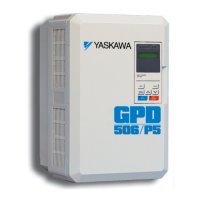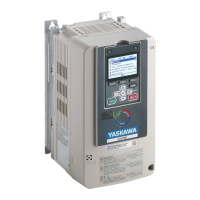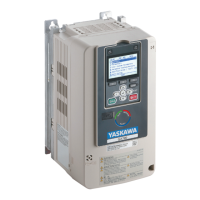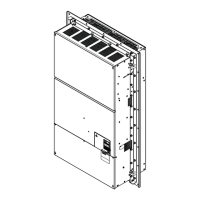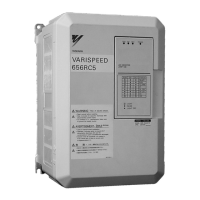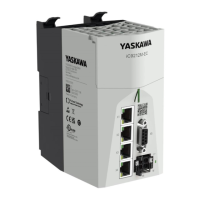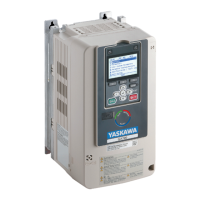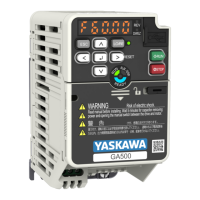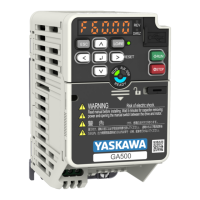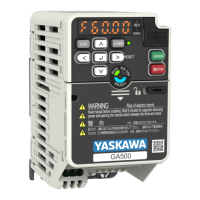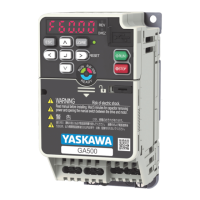Receiving
1
1.3 Features and Advantages of Control Methods
YASKAWA SIEPC71061705H GA700 Series Technical Manual 27
1.3 Features and Advantages of Control Methods
This drive has 9 available control methods from which you can select for different applications. Table 1.5, Table
1.6 and Table 1.7 give information about the features of each control method.
Table 1.5 V/f and CL-V/f Features and Advantages of Control Methods
Control Method
Selection
Open Loop V/f Control
(V/f)
V/f Control with Encoder
(CL-V/f)
Notes
Controlled Motor Induction Motor -
Parameter Settings A1-02 = 0 A1-02 = 1 -
Basic Control V/f
Closed loop V/f control with speed
correction
-
Main Applications
General-purpose variable speed control to
connect more than one motor to one drive.
High-precision speed control with encoders
on machines
-
PG Option Card Not necessary Necessary (PG-B3 or PG-X3) -
Maximum Output Frequency 590 Hz 400 Hz -
Speed Control Range 1:40 1:40
This is the range of variable control.
When you connect and operate motors in this mode,
think about the increase in motor temperature.
Starting Torque 150% / 3 Hz 150% / 3 Hz
This is the motor torque that the drive can supply at
low speed during start-up and the related output
frequency (rotation speed).
When a large quantity of torque is necessary at low
speed, you must think about drive capacity and motor
capacity.
Auto-Tuning
*1
Rotational and Line-to-Line Resistance
(usually not necessary)
Rotational and Line-to-Line Resistance
(usually not necessary)
Automatically tunes electrical motor parameters.
Torque Limits
*1
No No
Controls maximum motor torque to prevent damage to
machines and loads.
Torque Control
*1
No No
Directly controls motor torque to control tension and
other parameters.
Droop Control
*1
No No
Sets load torque slip for motors. Distributes motor
loads.
Zero Servo Control
*1
No No
Locks servos without an external position controller to
prevent movement caused by external force.
Speed Search
*1
Yes -
Immediately estimates (or detects) motor speed and
direction when coasting to a stop to quickly start-up
the drive without stopping the motor.
Automatic Energy-saving
Control
*1
Yes Yes
Automatically adjusts the voltage that the drive applies
to the motor to maximize motor efficiency for small
and large loads.
High Slip Braking (HSB)
*1
Yes Yes
Increases motor loss to let the motor decelerate faster
than usual without a braking resistor. Motor
characteristics have an effect on this function.
Feed Forward Control
*1
No No
Compensates effects of the system inertia to increase
the speed precision when the load changes.
KEB Ride-Thru Function
*1
Yes Yes
Quickly and safely stops the motor during power loss
and automatically starts operation at the previous
speed when the drive applies power again without
coasting the motor.
Overexcitation Deceleration
*1
Yes Yes
Sets the V/f higher than the setting value during
deceleration to increase motor loss and decrease
deceleration time.
Overvoltage Suppression
Function
*1 *2
Yes Yes
Adjusts speed during regeneration to prevent
overvoltage.
*1 Note these points when you use this function:
• When you can decouple the motor and machine for a test run, use Rotational Auto-Tuning. You must make adjustments to the
control in the range where there is no vibration in the machine after Rotational Auto-Tuning.
• Motor loss increases during overexcitation braking and high-slip braking. Use a maximum braking frequency of 5% ED and a
maximum braking time of 90 seconds. After you start high-slip braking, you cannot restart the motor until it stops. Use
overexcitation braking to decelerate over a shorter time at a pre-determined speed.
*2 Do not use this function with hoist application.
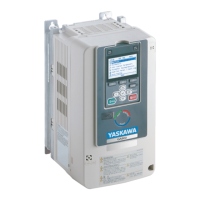
